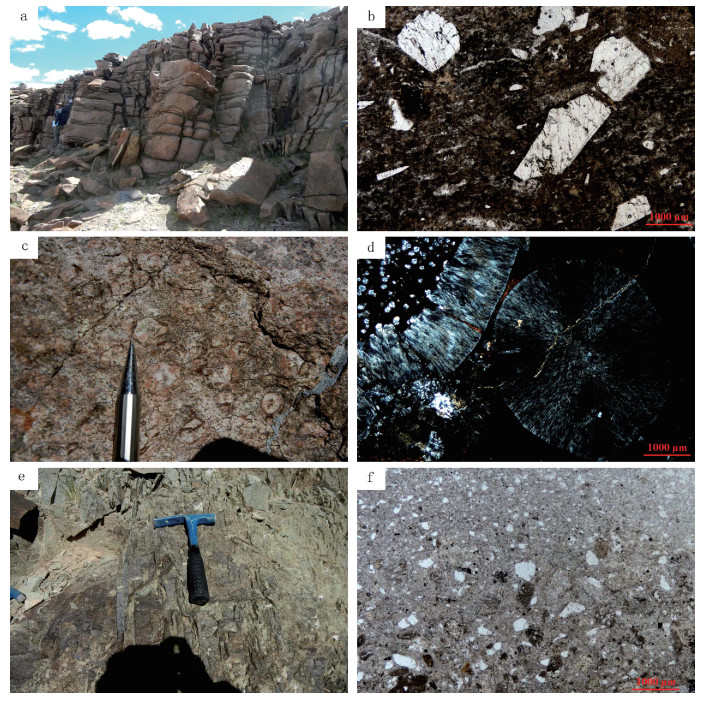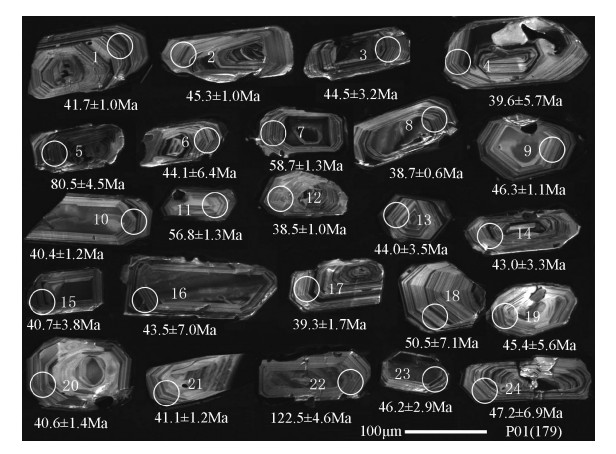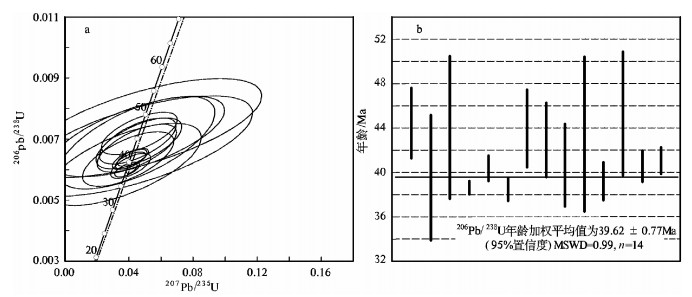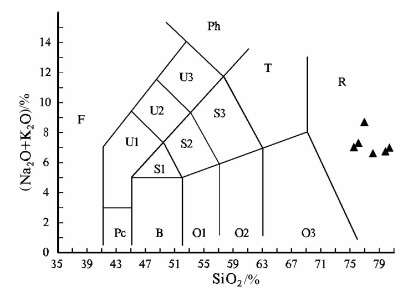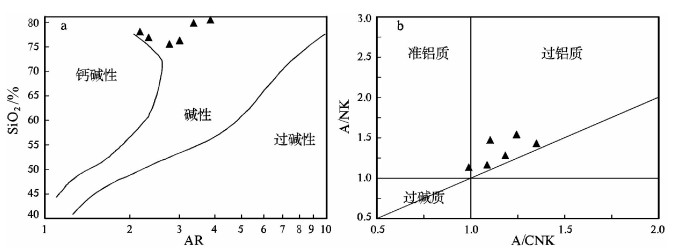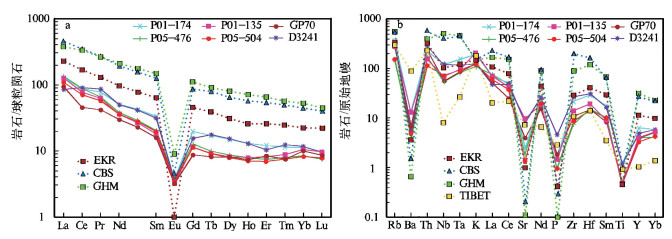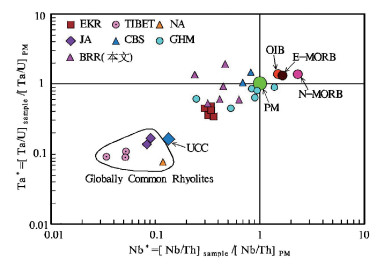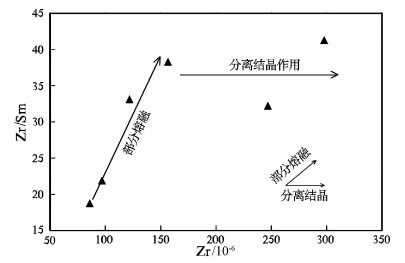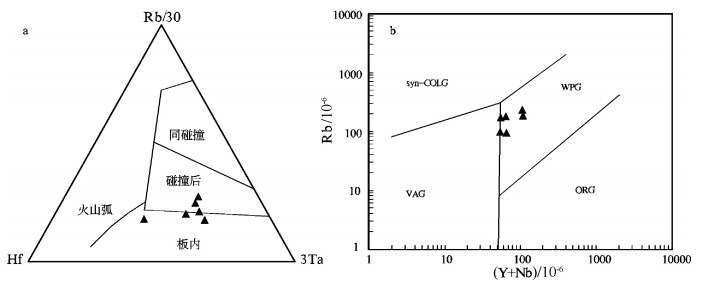Zircon U-Pb age, geochemistry and geological signifi-cance of high Nb-Ta acid volcanic rocks from Meisu Formation, Bieruo-Zecuo area, Gangdise belt
-
摘要:
别若则错地区美苏组构造上处于北冈底斯南缘,其中流纹岩的LA-ICP-MS锆石206Pb/238U年龄为39.62±0.77Ma,时代为晚始新世。岩石具高SiO2(72.85%~78.54%)、富碱(Alk=6.36%~8.47%)、贫CaO(0.33%~1.56%)和MgO(0.08%~0.58%)特征,A/CNK=0.99~1.35,属于弱铝质-过铝质碱性系列。稀土元素总量为122.52×10-6~208.35×10-6,(La/Yb)N值为7.27~16.11,δEu=0.13~0.26,在球粒陨石标准化稀土元素分布模式上表现为Eu的右倾V字形。微量元素Nb(38.1×10-6~88.7×10-6)、Ta(3.36×10-6~6.35×10-6)高,Rb、K、Th、Ce、Zr、Hf相对富集,Ba、Sr、P、Ti强烈亏损。岩石地球化学特征表明,别若则错地区美苏组酸性火山岩“集壳幔特性于一身”,是初始熔体为富碱和富Nb、Ta的幔源玄武质岩浆与壳源岩浆以某一特定比例混合/混染的产物。初步认为,美苏组酸性火山岩产出于大陆板内伸展(裂谷)环境,其地球动力学背景与南侧新特提斯洋壳向北俯冲,导致高原内部的陆内俯冲、走滑剪切与地壳缩短有关。
Abstract:Meisu Formation in Bieruo-Zecuo area is tectonically located on the south margin of north Gangdise belt. LA-ICP-MS zircon 206Pb/238U dating shows that rhyolite from Meisu Formation has an age of 39.62±0.77Ma (n=14, MSWD=0.99), corresponding to Late Eocene. Geochemistry shows that the rhyolite belongs to weakly aluminous to peraluminous alkaline series (A/CNK=0.99~1.35) with characteristics of high SiO2 (72.85%~78.54%), high alkali (Alk=6.36%~8.47%), low CaO (0.33%~1.56%) and low MgO (0.08%~0.58%). The chondrite-normalized REE patterns are characterized by the significant enrichment of LREE (LaN/YbN=7.27~16.11) and strong negative Eu anomalies (δEu=0.13~0.26) with total REE content of 122.52×10-6~208.35×10-6. The primitive man-tle-normalized trace element spider diagram shows high content of Nb (38.1×10-6~88.7×10-6) and Ta (3.36×10-6~6.35×10-6), rela-tive enrichment of Rb, K, Th, Ce, Zr and Hf and strong depletion of Ba, Sr, P and Ti. These geochemical characteristics show that the Meisu rhyolite is the product of mixing/contamination by a specific proportion of alkali-rich, Nb-Ta enriched, mantle-derived basaltic magma and crust-derived magma. The authors hold that the Meisu rhyolite was formed in an intraplate extension environ-ment (rift). Geodynamically, the formation of those rocks was associated with the on-plateau intracontinental subduction, strike-slip shear, and crust shortening triggered by northward subduction of Tethys Oceanic crust on the southern side.
-
Keywords:
- Gangdise belt /
- Bieruo-Zecuo area /
- Meisu Formation /
- high Nb-Ta /
- LA-ICP-MS zircon U-Pb dating /
- geochemistry
-
冈底斯巨型构造-岩浆带夹持于印度河-雅鲁藏布缝合带(IYZSZ)与班公湖-怒江缝合带(BN⁃SZ)之间[图1-a],带内发育大量中—新生代中酸性火山岩[2]。美苏组出露于班戈-八宿地层分区及狮泉河-永珠-嘉黎构造-地层分区[3]。该组为江西地调院实施1: 25万邦多区幅和措麦区幅地质调查时创建,其定义为不整合于晚白垩世竟柱山组之上的一套以基性-中性-酸性-酸碱性火山熔岩为主,夹火山碎屑岩的岩石组合,代表裂隙-中心式喷发-沉积的火山岩系[4],时代归属古新世—始新世[4-5]。该套岩石组合在尼玛地区被先后归属于达多群②、达多组③及林子宗群[6]。1: 5万撞多勒幅区调工作,据地层岩性组合、火山喷发方式、喷发-沉积环境及岩浆演化特点,将出露于别若则错地区的一套以酸性火山熔岩、酸性火山碎屑岩夹少量砂岩的组合归属于美苏组④,该套岩石组合前人曾归属于江巴组①⑤、竟柱山组[6]。美苏组创建以来,除建组时有少量岩石学、岩石化学特征描述外,后期1: 5万调查也仅进行了岩性对比,未见相关报道。本文在野外调查的基础上,根据锆石U-Pb年龄,结合地球化学特征,探讨了美苏组流纹岩的成因和大地构造背景,为认识冈底斯北部新生代岩浆-构造演化提供基础资料。
![]() 1—第四系;2—早-晚白垩世美苏组;3—晚白垩世竟柱山组;4—早白垩世去申拉组;5—早白垩世多尼组;6—晚侏罗世日松组; 7—晚侏罗世多仁组;8—早-中侏罗世拉贡塘组;9—晚二叠世下拉组;10—晚石炭世拉嘎组;11—中始新世钾长花岗岩; 12—晚白垩世闪长岩;13—早白垩世石英闪长岩;14—地质界线;15—角度不整合界线;16—区域大断裂;17—一般断裂; 18—推测断裂;19—测年样品采集位置(本项目测试);20—研究区位置;NQFAB—那曲弧前盆地;NG—北冈底斯; MG—中冈底斯;GBAFUB—冈底斯弧背断隆带;SG—南冈底斯; SMLMF—沙莫勒-麦拉-洛巴堆-米拉山断裂; GLZCF—噶尔-隆格尔-扎日南木错-措麦断裂带;SLYNJOMZ—獅泉河-拉果错-永珠-纳木错- 嘉黎蛇绿混杂岩带;BNSZ—班公湖-怒江缝合带;IYZSZ—印度河-雅鲁藏布缝合带Figure 1. Geological sketch map of tectonic units of Gangdise (a) and geological sketch map of the Bierou-Zecuo area (b)
1—第四系;2—早-晚白垩世美苏组;3—晚白垩世竟柱山组;4—早白垩世去申拉组;5—早白垩世多尼组;6—晚侏罗世日松组; 7—晚侏罗世多仁组;8—早-中侏罗世拉贡塘组;9—晚二叠世下拉组;10—晚石炭世拉嘎组;11—中始新世钾长花岗岩; 12—晚白垩世闪长岩;13—早白垩世石英闪长岩;14—地质界线;15—角度不整合界线;16—区域大断裂;17—一般断裂; 18—推测断裂;19—测年样品采集位置(本项目测试);20—研究区位置;NQFAB—那曲弧前盆地;NG—北冈底斯; MG—中冈底斯;GBAFUB—冈底斯弧背断隆带;SG—南冈底斯; SMLMF—沙莫勒-麦拉-洛巴堆-米拉山断裂; GLZCF—噶尔-隆格尔-扎日南木错-措麦断裂带;SLYNJOMZ—獅泉河-拉果错-永珠-纳木错- 嘉黎蛇绿混杂岩带;BNSZ—班公湖-怒江缝合带;IYZSZ—印度河-雅鲁藏布缝合带Figure 1. Geological sketch map of tectonic units of Gangdise (a) and geological sketch map of the Bierou-Zecuo area (b)1. 地质概况及岩石学特征
研究区美苏组出露于别若则错北东约10km,北西-南东向展布,宽0.8~3.0km,构造上处于北冈底斯南缘,以发育侏罗系—古近系火山沉积及大量白垩纪基性-中酸性侵入岩为特征(图 1-b)。地层不整合于早白垩世去申拉组之上,其上仅见第四系覆盖。美苏组岩性以浅灰色、紫红色流纹质火山角砾岩、凝灰岩、流纹岩、安山岩为主,夹灰绿色斑状、杏仁状玄武岩、玄武质火山集块岩、紫红色砂岩、黑色硅质岩等,流纹岩中可见大量的石泡构造。在走向上岩性、岩相较稳定,但厚度变化较大。本区美苏组与层型剖面[4]对比,同样表现为基性-中性-酸性的岩石组合,但厚度更大,可达1232.65m。
本文采集的样品为美苏组酸性熔岩及酸性火山碎屑岩两大类,岩石呈浅灰色、紫红色。流纹岩(图版Ⅰ-a)具斑状结构,基质为显微晶质结构(图版Ⅰ-b),斑晶为石英(约3%),0.1~2.3mm,多被熔蚀为次圆状,透长石(约7%)呈半自形板状、他形粒状,少量红褐色具暗化边片状黑云母;基质为显微晶质状的斜长石、钾长石,以钾长石为主,次为石英、磁铁矿,岩石有弱的粘土、绢云母蚀变。球粒流纹岩(图版Ⅰ-c)具球粒结构(图版Ⅰ-d)球粒(约75%)呈圆状、椭圆状,粒径0.1~16mm,由纤维状的长英质组成,部分脱玻化形成纤维状雏晶石英,少量球粒含透长石(约3%)、石英斑晶(约4%),胶结物为流纹质熔岩(约16%)及褐铁矿(约3%),流纹质熔岩呈隐晶质状,部分胶结物沿球粒边部形成细小的椭圆状球粒,排列呈孔雀羽毛状分布。流纹质(晶屑岩屑)凝灰岩(图版Ⅰ-e)为火山凝灰结构(图版Ⅰ-f),凝灰质含量43%~80%,由石英、长石等晶屑及流纹岩、粗面岩岩屑组成,胶结物主要为小于0.05mm的隐晶质火山灰,少量重结晶的长英质物质,岩石具褐铁矿、方解石等轻微蚀变。
2. 锆石U-Pb年龄
锆石单矿物分选由四川华阳岩矿测试中心完成。西北大学大力动力学国家重点实验室进行阴极发光(CL)图像采集及LA-ICP-MS锆石U-Pb测年。采用标准锆石91500校正Pb/U同位素分馏。激光器为ArF193nm紫外准分子激光器,单脉冲能量220mJ,最高重复频率20Hz,能量密度可达20J/cm2,剥蚀直径20μm左右。为了控制仪器的稳定性及测试精度,每测试5个未知样后测定1次标准样。数据处理采用Glitter(ver4.0,Macquarie University)和Isoplo(tver2.49)软件程序[7]。
锆石U-Pb年龄样品(P01(179))采集于美苏组上部流纹岩内,其位置为北纬32°28′03″、东经83°07′24″(图 1-b)。样品选取24颗锆石进行LA-ICP-MS法U-Pb测年,分析锆石为无色-浅黄色透明,颗粒形状规则,主要表现为柱状自形晶,粒径为80~120μm,个别可达190μm,长宽比为1~2(图版Ⅰ)。CL图像表现出典型的岩浆韵律环带和明暗相间的条带结构(图 2),属无核岩浆结晶锆石,可代表流纹岩的成岩年龄。测试数据结果见表 1,共测得24个数据,其U-Pb谐和图见图 3-a,最小的14个测点(1、3、4、6、8、10、12~17、20、21)的206Pb/238U年龄为38.5±1.0~44.5±3.2Ma,给出的加权平均值为39.62±0.77Ma(MSWD=0.99,置信度95%)(图 3-b),可代表流纹岩的结晶时代,为晚始新世。
表 1 美苏组流纹岩(P01(179))LA-ICP-MS锆石U-Th-Pb同位素分析数据Table 1. LA-ICP-MS zircon U-Th-Pb isotopic analyses of Meisu Formation rhyolite (P01(179))测点 同位素比值 年龄/Ma 206Pb/38U 1σ 207Pb/235U 1σ 207Pb/206Pb 1σ 208Pb/232Th 1σ 206Pb/238U 1σ 207Pb/235U 1σ 208Pb/232Th 1σ 1 0.00649 0.00016 0.09509 0.0067 0.10627 0.00837 0.00249 0.00007 41.7 1.0 92.2 6.2 50.3 1.4 2 0.00705 0.00016 0.14056 0.00768 0.14458 0.00930 0.00368 0.00011 45.3 1.0 133.5 6.8 74.3 2.2 3 0.00693 0.00050 0.04572 0.01574 0.04783 0.01684 0.00286 0.00028 44.5 3.2 45.4 15.3 57.7 5.7 4 0.00616 0.00089 0.03751 0.03158 0.04416 0.03769 0.00161 0.00039 39.6 5.7 37.4 30.9 32.4 7.9 5 0.01257 0.00071 0.83390 0.06569 0.48128 0.04763 0.01336 0.00065 80.5 4.5 615.8 36.4 268.2 12.9 6 0.00687 0.00100 0.04494 0.03232 0.04747 0.03481 0.00322 0.00078 44.1 6.4 44.6 31.4 65.1 15.7 7 0.00914 0.00020 0.42774 0.01499 0.33927 0.01643 0.00857 0.00019 58.7 1.3 361.6 10.7 172.4 3.8 8 0.00602 0.00010 0.04187 0.00225 0.05043 0.00312 0.00186 0.00003 38.7 0.6 41.7 2.2 37.6 0.7 9 0.00720 0.00017 0.19359 0.00937 0.19487 0.01157 0.00470 0.00013 46.3 1.1 179.7 8.0 94.8 2.5 10 0.00629 0.00018 0.04126 0.00621 0.04754 0.00738 0.00214 0.00010 40.4 1.2 41.1 6.1 43.2 2.1 11 0.00885 0.00020 0.35398 0.01403 0.2902 0.01516 0.00866 0.00021 56.8 1.3 307.7 10.5 174.3 4.3 12 0.00599 0.00016 0.03905 0.00508 0.04727 0.00638 0.00210 0.00008 38.5 1.0 38.9 5.0 42.4 1.6 13 0.00685 0.00055 0.04638 0.01763 0.04907 0.01907 0.00271 0.00034 44.0 3.5 46 17.1 54.8 6.9 14 0.00669 0.00052 0.04518 0.01635 0.04896 0.01814 0.00185 0.00024 43.0 3.3 44.9 15.9 37.3 4.8 15 0.00633 0.00059 0.03968 0.01884 0.04543 0.02198 0.00245 0.00042 40.7 3.8 39.5 18.4 49.4 8.5 16 0.00676 0.00109 0.04464 0.04805 0.04787 0.05206 0.00224 0.00056 43.5 7.0 44.3 46.7 45.3 11.3 17 0.00611 0.00027 0.04128 0.00827 0.04898 0.01012 0.00197 0.00010 39.3 1.7 41.1 8.1 39.8 2.1 18 0.00787 0.00111 0.13800 0.05582 0.12715 0.05431 0.00265 0.00054 50.5 7.1 131.3 49.8 53.5 10.8 19 0.00707 0.00087 0.04625 0.03535 0.04744 0.03672 0.00286 0.00059 45.4 5.6 45.9 34.3 57.8 11.9 20 0.00632 0.00022 0.04044 0.00711 0.04640 0.00840 0.00210 0.00014 40.6 1.4 40.3 6.9 42.5 2.9 21 0.00639 0.00019 0.04269 0.00639 0.04842 0.00748 0.00223 0.00012 41.1 1.2 42.4 6.2 45 2.4 22 0.01918 0.00072 1.48434 0.07226 0.56111 0.0364 0.02164 0.00066 122.5 4.6 924 29.5 432.8 13.2 23 0.00719 0.00046 0.04674 0.01563 0.04711 0.01607 0.00305 0.00035 46.2 2.9 46.4 15.2 61.5 7.0 24 0.00735 0.00107 0.04872 0.04896 0.04808 0.04881 0.00356 0.00058 47.2 6.9 48.3 47.4 71.9 11.7 3. 岩石地球化学
主量、稀土及微量元素样品加工由华阳地矿检测中心实验室完成,测试由国土资源部武汉矿产资源监督检测中心武汉综合岩矿测试中心完成。主量、微量和稀土元素检测采用AXIOS X射线荧光光谱仪、X Series2等离子质谱仪、IRIS Intripid2XSP ICP全谱直读光谱仪、ZEEnit600石墨炉原子吸收光谱仪、AFS-230E原子荧光分光光度计分析。美苏组流纹岩主量、稀土及微量元素分析结果见表 2。
表 2 美苏组酸性火山岩主量、微量和稀土元素分析结果Table 2. Major, trace elements and REE analyses of acid volcanic rocks from Meisu Formation样品 流纹岩 流纹质凝灰岩 P01(174) D3241☆ P05(504) P01(135) GP70☆ P05(476) SiO2 72.85 74.04 78.54 74.82 75.60 77.48 Al2O3 12.39 14.25 10.76 12.03 12.83 11.34 Fe2O3 1.23 1.42 0.69 0.67 0.37 0.55 FeO 0.16 0.54 0.10 0.10 0.44 0.09 CaO 1.56 0.33 0.37 0.86 1.09 0.40 MgO 0.22 0.55 0.31 0.20 0.08 0.58 K2O 5.47 2.25 3.56 5.87 3.77 3.33 Na2O 1.52 4.59 3.28 2.60 2.59 3.19 TiO2 0.25 0.10 0.10 0.10 0.10 0.11 P2O5 0.03 0.03 0.02 0.03 0.04 0.02 MnO 0.09 0.02 0.02 0.11 0.03 0.09 灼失 4.15 1.20 2.22 2.53 2.31 2.79 H2O+ 2.46 0.92 1.78 1.85 1.72 2.16 H2O- 0.44 0.12 0.73 1.16 0.18 1.31 CO2 1.67 ― 0.19 0.71 - 0.68 总和 99.92 99.32 99.97 99.92 99.25 99.97 AR 3.01 2.77 3.87 2.35 2.19 3.38 NK/A 0.68 0.70 0.86 0.88 0.65 0.78 A/CNK 1.10 1.35 1.08 0.99 1.24 1.18 Cr 4.29 11.00 5.72 4.96 1.00 5.32 Ni 2.26 16.00 2.72 1.56 13.4 2.44 Co 3.67 4.80 8.34 3.78 1.00 6.36 Rb 228 185 94.2 176 174 98 Cs 5.05 5.00 21.60 7.76 8.50 15.90 W 44.5 1.8 82.1 35.8 2.2 55.5 Sr 51.6 170 28.8 203 84.4 38 Ba 94.8 38 35.1 90.1 48.2 28.1 V 8.18 4.4 5.01 4.21 1.36 8.41 Nb 80.7 88.7 51.0 48.1 40.0 38.1 Ta 6.35 4.97 3.36 3.96 3.54 3.54 Zr 247 298 97.2 156 122 85.4 Hf 8.96 9.40 4.38 5.84 4.71 4.66 U 1.69 4.18 2.91 2.20 1.34 3.39 Th 20.5 25.7 9.86 13.1 20.4 14.4 La 47.9 32.0 41.4 47.8 35.4 51.6 Ce 84.6 88.0 68.0 74.9 43.9 86.6 Pr 10.60 12.00 7.96 8.51 5.80 8.96 Nd 36.4 36.0 25.6 25.3 21.2 27.2 Sm 7.70 7.20 4.43 4.08 3.68 4.59 Eu 0.31 0.32 0.3 0.27 0.28 0.34 Gd 6.19 4.80 3.53 3.46 2.74 3.97 Tb 0.98 1.00 0.51 0.51 0.46 0.56 Dy 5.83 6.00 3.04 3.11 3.14 3.32 Ho 1.13 1.10 0.61 0.67 0.64 0.68 Er 2.99 2.6 1.74 2.02 2.16 1.89 Tm 0.45 0.50 0.30 0.35 0.30 0.31 Yb 2.90 2.90 2.07 2.56 2.49 2.11 Lu 0.37 0.37 0.30 0.37 0.33 0.29 Y 27.7 22.0 15.2 17.9 17.6 17.7 ∑REE 208.35 194.79 159.79 173.91 122.52 192.42 δEu 0.13 0.16 0.23 0.22 0.26 0.24 (La/Yb)N 10.88 7.27 13.17 12.3 9.37 16.11 注:☆样品据参考文献①;AR=(Al2O3+CaO+Na2O+K2O)/(Al2O3+CaO-Na2O-K2O);NK/A=(Na2O+K2O)/Al2O3(摩尔比); A/CNK=Al2O3/(CaO+Na2O+K2O)(摩尔比);主量元素含量单位为%,微量和稀土元素为10-6 3.1 主量元素
美苏组酸性火山岩主量元素特征表现为高SiO2(72.85%~78.54%,平均75.56%)、富碱(Alk=6.36%~ 8.47%,平均7.00%)、贫CaO(0.33% ~1.56%,平均0.77%)和MgO(0.08%~0.58%,平均0.32%)。K2O/Na2O值(除D3241)大于1(1.04~3.60),平均值为1.66。很高的K含量及高K/Na值,普遍被理解为在部分熔融的过程中,受控于源区较高的K含量[8-9],或者是较低的分熔程度[10]。在TAS分类图解(图 4)中,样品点均落入流纹岩系列。在AR-SiO2图解(图 5-a)中,样品点主要落在碱性区域。NK/A=0.65~0.86(平均0.76),A/CNK=0.99~1.35(平均1.16).CIPW计算结果表明,所有样品都含有标准矿物刚玉分子,刚玉分子为0.91~3.76,在A/CNK-A/NK图(图 5-b)上,主要落入过铝质区(1个样品为准铝质),过铝质的花岗质岩石是壳源的[16],主要与大陆碰撞中沉积岩的重熔作用有关[17]。值得关注的是,该套火山岩具有很低的TiO2含量(0.10% ~0.25%,平均0.13%),低于岛弧区钙碱系列酸性火山岩类(0.50%)[18]及大陆板内常见酸性岩类[19],暗示该套火山岩经历过一定程度的分离结晶作用,由于钛铁氧化物的早期分离结晶,造成岩石中偏低的TiO2含量[20]。
![]() 图 4 美苏组酸性火山岩TAS分类图解[11]Pc—苦橄玄武岩; B—玄武岩; O1—玄武安山岩; O2—安山岩; O3—英安岩; R—流纹岩; S1—粗面玄武岩; S2—玄武质粗面安山岩;S3—粗面安山岩;T—粗面岩、粗面英安岩;F—副长石岩;U1—碱玄岩、碧玄岩;U2—响岩质碱玄岩;U3—碱玄质响岩;Ph—响岩Figure 4. TAS diagram of acid volcanic rocks of the Meisu Formation
图 4 美苏组酸性火山岩TAS分类图解[11]Pc—苦橄玄武岩; B—玄武岩; O1—玄武安山岩; O2—安山岩; O3—英安岩; R—流纹岩; S1—粗面玄武岩; S2—玄武质粗面安山岩;S3—粗面安山岩;T—粗面岩、粗面英安岩;F—副长石岩;U1—碱玄岩、碧玄岩;U2—响岩质碱玄岩;U3—碱玄质响岩;Ph—响岩Figure 4. TAS diagram of acid volcanic rocks of the Meisu Formation3.2 稀土和微量元素
美苏组酸性火山岩稀土元素总量为123×10-6~ 208×10-6,在球粒陨石标准化稀土元素分布模式图(图 6-a)上,轻稀土元素(LREE)略向右倾斜,重稀土元素(HREE)较平缓,轻稀土元素分馏程度略高于重稀土元素,(La/Yb)N值为7.27~16.11,δEu=0.13~0.26,显示右倾的V字形分布模式,近似于“海鸥型”,与典型碱流岩几乎完全一致[10]。强烈的负Eu异常,反映岩石在形成过程中有斜长石的结晶分离或源区部分熔融残留斜长石[21]。
在原始地幔标准化蛛网图(图 6-b)上,曲线显示右倾富集型分布型式。曲线前半部分元素总体呈富集状态,后半部分相容元素富集度较低,表现为板内火山岩的地球化学特征[20],表明其应来自大陆板内深部局部熔融[19]。岩石大离子亲石元素Rb、K及高场强元素Th、Ce、Zr、Hf相对富集,高场强元素Nb、Ta相对亏损,大离子亲石元素Ba、Sr及高场强元素P、Ti强烈亏损,类似于东昆仑高Nb-Ta流纹岩,并可以与典型的碱流岩对比[10]。需要说明的是,Nb、Ta虽然有微弱的负异常,但其高Nb(38×10-6~89×10-6,平均58× 10-6)、Ta(3×10-6~6×10-6,平均4×10-6)含量与冈底斯带同时期的酸性火山岩的Nb、Ta强烈亏损截然不同[10, 24-25]。
4. 讨论
4.1 岩石源区及岩石成因
地球化学特征显示,美苏组酸性火山岩具有高硅、富铝、富碱,贫CaO、MgO的特征,大离子亲石元素及高场强元素Rb、K、Th、Ce、Zr、Hf相对富集,Ba、Sr、P、Ti强烈亏损,暗示岩浆可能来源于大陆板内深部的局部熔融。酸性火山岩的Rb/Sr、Ti/Y和Ti/Zr值分别为0.9~4.4(平均2.4)、35.1~70.6(平均45.9)和3.9~7.9(平均5.8),位于壳源岩浆(Rb/Sr > 0.5,Ti/Y < 100,Ti/Zr < 20)范围[26-27]内,是陆壳熔融的产物。
Nb、Ta在侵蚀和变质作用过程中较稳定,有示踪原始岩浆源区的特征[28-29]。单纯的地壳熔融成因与美苏组酸性火山岩显示的高Nb、Ta及强烈亏损Sr、Eu、Ba的微量元素特征不符,这是由于地壳具有继承性的Nb、Ta负异常,如果没有其他富集Nb、Ta岩浆的加入,任何程度的地壳部分熔融和分离结晶都无法产生高Nb、Ta含量的熔体[10]。美苏组酸性火山岩Nb/Ta=10.8~17.9(平均13.3),1个样品在幔源岩浆值(17±1)[30]范围,其他则略小于幔源岩浆值,也可以说明岩浆源有幔源物质参与。别若则错地区美苏组酸性火山岩Nb*≈1、Ta*≈>1,与典型的碱流岩分布范围近于一致(图 7),典型碱流岩CBS和GHM(AI > 1)呈现出Nb-Ta正异常,其由碱性玄武岩分离结晶形成,很少或没有受到陆壳混染[10]。
由上述分析可知,区内美苏组酸性火山岩的地球化学特征具有“集壳幔特性于一身”的属性,因此,笔者认为,形成本区酸性火山岩的初始熔体为富碱和富Nb、Ta的幔源玄武质岩浆与壳源岩浆以某一特定比例混合/混染的产物,混染应该发生在上地壳,因此有轻微的Nb、Ta负异常。同时,由于酸性火山岩具有明显的负Eu异常(δEu=0.13~0.26),不能完全排除分离结晶形成部分酸性火山岩的可能性(图 8)。这种富Nb-Ta玄武岩浆一般具板内玄武岩的特征,可能反映裂谷伸展背景甚至地幔柱活动[10]。
4.2 构造环境
不同学者对于印度大陆与亚洲大陆的碰撞过程有不同的认识,有学者认为, 印度与亚洲大陆碰撞自65Ma或70Ma左右开始,到45Ma或40Ma左右完成,以后转入后碰撞期[31-34],主碰撞期为55~50Ma[35];也有学者认为,印度-亚洲大陆碰撞经历主碰撞(65~41Ma)、晚碰撞(40~26Ma)和后碰撞过程(25~0Ma)[36],并将早期碰撞过程划分为4个阶段:①70~60Ma,新特斯洋板片回转,印度大陆与亚洲大陆发生碰撞(≥65Ma),导致加厚地壳深熔;②60~54Ma,印度大陆板片向北陡深俯冲,下地壳缩短加厚,地壳深熔作用持续;③53~41Ma,新特提斯洋板片发生断离,并向下拆沉。软流圈物质透过板片断离窗上涌,诱发地幔楔、上覆加厚的镁铁质下地壳熔融;④陡深俯冲的印度大陆板片因特提斯洋板片断离而发生折返,开始低角度俯冲(<40Ma),导致高原内部的陆内俯冲、走滑剪切与地壳缩短,造成冈底斯岩浆间断(40~26Ma)和拉萨地体初始抬升[24]。别若则错美苏组酸性火山岩位于北冈底斯南缘,流纹岩LA-ICP-MS锆石206Pb/238U年龄为39.62±0.77Ma(n=14,MSWD=0.99),时代为晚始新世。该时期印度大陆与亚洲大陆板块主碰撞已完成,是印度大陆与亚洲大陆板块后碰撞期[31-34]或晚碰撞期[36]的起始时间。美苏组火山岩在命名地尼玛地区具“双峰式”特点,被认为属于造山带向板内过渡环境[4-5],在研究区被认为是局限的“伸展盆地”构造环境①。本次采集的美苏组酸性火山岩样品在Rb/30-Hf-3Ta图解(图 9-a)中,落入碰撞后和板内交汇区,在(Y+Nb)-Rb图解(图 9-b)中主要落入板内花岗岩区。结合地球化学特征,综合认为,晚始新世冈底斯带别若则错地区处于后碰撞阶段陆内伸展(裂谷)环境,南侧新特提斯洋壳向北俯冲,导致高原内部的陆内俯冲、走滑剪切,引发大范围地壳伸展减薄,软流圈物质上涌,上涌的软流圈物质为具有富碱和富Nb、Ta特征的幔源玄武质岩浆,幔源玄武质岩浆与上地壳壳源岩浆以某一特定比例混合/混染,形成研究区高Nb-Ta的酸性火山岩。
5. 结论
(1) 美苏组酸性火山岩显示的特征为高硅、富铝、富碱,贫CaO、MgO,高Nb、Ta,大离子亲石元素及高场强元素Rb、K、Th、Ce、Zr、Hf相对富集,Ba、Sr、P、Ti强烈亏损的特征,岩石地球化学特征表明,美苏组火山岩“集壳幔特性于一身”,是初始熔体为富碱、富Nb、Ta的幔源玄武质岩浆与壳源岩浆以某一特定比例混合/混染的产物。
(2) 通过LA-ICP-MS锆石U-Pb测年,获得岩石结晶年龄为39.62±0.77Ma(n=14,MSWD=0.99),形成时代为晚始新世。
(3) 美苏组酸性火山岩产于大陆板内伸展(裂谷)环境,其地球动力学背景与南侧新特提斯洋壳向北俯冲,导致高原内部的陆内俯冲、走滑剪切与地壳缩短有关。
致谢: 参加工作的主要成员还有四川省地矿局区域地质调查队曾伟、邵志伟、唐广成、朱国宝工程师、余旭辉博士等,锆石U-Pb测年得到西北大学大力动力学国家重点实验室第五春荣博士的大力支持,审稿专家对稿件提出了宝贵修改意见,在此一并表示诚挚的感谢。 -
图 1 冈底斯构造单元划分(a[1])和别若则错地区地质简图(b,据参考文献①修改)
1—第四系;2—早-晚白垩世美苏组;3—晚白垩世竟柱山组;4—早白垩世去申拉组;5—早白垩世多尼组;6—晚侏罗世日松组; 7—晚侏罗世多仁组;8—早-中侏罗世拉贡塘组;9—晚二叠世下拉组;10—晚石炭世拉嘎组;11—中始新世钾长花岗岩; 12—晚白垩世闪长岩;13—早白垩世石英闪长岩;14—地质界线;15—角度不整合界线;16—区域大断裂;17—一般断裂; 18—推测断裂;19—测年样品采集位置(本项目测试);20—研究区位置;NQFAB—那曲弧前盆地;NG—北冈底斯; MG—中冈底斯;GBAFUB—冈底斯弧背断隆带;SG—南冈底斯; SMLMF—沙莫勒-麦拉-洛巴堆-米拉山断裂; GLZCF—噶尔-隆格尔-扎日南木错-措麦断裂带;SLYNJOMZ—獅泉河-拉果错-永珠-纳木错- 嘉黎蛇绿混杂岩带;BNSZ—班公湖-怒江缝合带;IYZSZ—印度河-雅鲁藏布缝合带
Figure 1. Geological sketch map of tectonic units of Gangdise (a) and geological sketch map of the Bierou-Zecuo area (b)
图 4 美苏组酸性火山岩TAS分类图解[11]
Pc—苦橄玄武岩; B—玄武岩; O1—玄武安山岩; O2—安山岩; O3—英安岩; R—流纹岩; S1—粗面玄武岩; S2—玄武质粗面安山岩;S3—粗面安山岩;T—粗面岩、粗面英安岩;F—副长石岩;U1—碱玄岩、碧玄岩;U2—响岩质碱玄岩;U3—碱玄质响岩;Ph—响岩
Figure 4. TAS diagram of acid volcanic rocks of the Meisu Formation
图 6 美苏组酸性火山岩稀土元素球粒陨石标准化分布曲线(a)和微量元素原始地幔标准化蛛网图(b)(球粒陨石和原始地幔标准比值分别据参考文献[22-23])
EKR—东昆仑高Nb-Ta流纹岩, 构造环境:俯冲-碰撞晚期; TIBET—西藏冈底斯造山带林子宗火山岩帕那组流纹岩, 构造环境:陆陆碰撞; CBS—长白山碱流岩, 构造环境:弧后拉张; GHM—澳大利亚Glass House Mountain碱流岩, 构造环境:板内(与热点有关)
Figure 6. Chondrite-normalized REE patterns (a) and primitive mantle normalized trace elements patterns (b) of acid volcanic rocks from Meisu Formation
表 1 美苏组流纹岩(P01(179))LA-ICP-MS锆石U-Th-Pb同位素分析数据
Table 1 LA-ICP-MS zircon U-Th-Pb isotopic analyses of Meisu Formation rhyolite (P01(179))
测点 同位素比值 年龄/Ma 206Pb/38U 1σ 207Pb/235U 1σ 207Pb/206Pb 1σ 208Pb/232Th 1σ 206Pb/238U 1σ 207Pb/235U 1σ 208Pb/232Th 1σ 1 0.00649 0.00016 0.09509 0.0067 0.10627 0.00837 0.00249 0.00007 41.7 1.0 92.2 6.2 50.3 1.4 2 0.00705 0.00016 0.14056 0.00768 0.14458 0.00930 0.00368 0.00011 45.3 1.0 133.5 6.8 74.3 2.2 3 0.00693 0.00050 0.04572 0.01574 0.04783 0.01684 0.00286 0.00028 44.5 3.2 45.4 15.3 57.7 5.7 4 0.00616 0.00089 0.03751 0.03158 0.04416 0.03769 0.00161 0.00039 39.6 5.7 37.4 30.9 32.4 7.9 5 0.01257 0.00071 0.83390 0.06569 0.48128 0.04763 0.01336 0.00065 80.5 4.5 615.8 36.4 268.2 12.9 6 0.00687 0.00100 0.04494 0.03232 0.04747 0.03481 0.00322 0.00078 44.1 6.4 44.6 31.4 65.1 15.7 7 0.00914 0.00020 0.42774 0.01499 0.33927 0.01643 0.00857 0.00019 58.7 1.3 361.6 10.7 172.4 3.8 8 0.00602 0.00010 0.04187 0.00225 0.05043 0.00312 0.00186 0.00003 38.7 0.6 41.7 2.2 37.6 0.7 9 0.00720 0.00017 0.19359 0.00937 0.19487 0.01157 0.00470 0.00013 46.3 1.1 179.7 8.0 94.8 2.5 10 0.00629 0.00018 0.04126 0.00621 0.04754 0.00738 0.00214 0.00010 40.4 1.2 41.1 6.1 43.2 2.1 11 0.00885 0.00020 0.35398 0.01403 0.2902 0.01516 0.00866 0.00021 56.8 1.3 307.7 10.5 174.3 4.3 12 0.00599 0.00016 0.03905 0.00508 0.04727 0.00638 0.00210 0.00008 38.5 1.0 38.9 5.0 42.4 1.6 13 0.00685 0.00055 0.04638 0.01763 0.04907 0.01907 0.00271 0.00034 44.0 3.5 46 17.1 54.8 6.9 14 0.00669 0.00052 0.04518 0.01635 0.04896 0.01814 0.00185 0.00024 43.0 3.3 44.9 15.9 37.3 4.8 15 0.00633 0.00059 0.03968 0.01884 0.04543 0.02198 0.00245 0.00042 40.7 3.8 39.5 18.4 49.4 8.5 16 0.00676 0.00109 0.04464 0.04805 0.04787 0.05206 0.00224 0.00056 43.5 7.0 44.3 46.7 45.3 11.3 17 0.00611 0.00027 0.04128 0.00827 0.04898 0.01012 0.00197 0.00010 39.3 1.7 41.1 8.1 39.8 2.1 18 0.00787 0.00111 0.13800 0.05582 0.12715 0.05431 0.00265 0.00054 50.5 7.1 131.3 49.8 53.5 10.8 19 0.00707 0.00087 0.04625 0.03535 0.04744 0.03672 0.00286 0.00059 45.4 5.6 45.9 34.3 57.8 11.9 20 0.00632 0.00022 0.04044 0.00711 0.04640 0.00840 0.00210 0.00014 40.6 1.4 40.3 6.9 42.5 2.9 21 0.00639 0.00019 0.04269 0.00639 0.04842 0.00748 0.00223 0.00012 41.1 1.2 42.4 6.2 45 2.4 22 0.01918 0.00072 1.48434 0.07226 0.56111 0.0364 0.02164 0.00066 122.5 4.6 924 29.5 432.8 13.2 23 0.00719 0.00046 0.04674 0.01563 0.04711 0.01607 0.00305 0.00035 46.2 2.9 46.4 15.2 61.5 7.0 24 0.00735 0.00107 0.04872 0.04896 0.04808 0.04881 0.00356 0.00058 47.2 6.9 48.3 47.4 71.9 11.7 表 2 美苏组酸性火山岩主量、微量和稀土元素分析结果
Table 2 Major, trace elements and REE analyses of acid volcanic rocks from Meisu Formation
样品 流纹岩 流纹质凝灰岩 P01(174) D3241☆ P05(504) P01(135) GP70☆ P05(476) SiO2 72.85 74.04 78.54 74.82 75.60 77.48 Al2O3 12.39 14.25 10.76 12.03 12.83 11.34 Fe2O3 1.23 1.42 0.69 0.67 0.37 0.55 FeO 0.16 0.54 0.10 0.10 0.44 0.09 CaO 1.56 0.33 0.37 0.86 1.09 0.40 MgO 0.22 0.55 0.31 0.20 0.08 0.58 K2O 5.47 2.25 3.56 5.87 3.77 3.33 Na2O 1.52 4.59 3.28 2.60 2.59 3.19 TiO2 0.25 0.10 0.10 0.10 0.10 0.11 P2O5 0.03 0.03 0.02 0.03 0.04 0.02 MnO 0.09 0.02 0.02 0.11 0.03 0.09 灼失 4.15 1.20 2.22 2.53 2.31 2.79 H2O+ 2.46 0.92 1.78 1.85 1.72 2.16 H2O- 0.44 0.12 0.73 1.16 0.18 1.31 CO2 1.67 ― 0.19 0.71 - 0.68 总和 99.92 99.32 99.97 99.92 99.25 99.97 AR 3.01 2.77 3.87 2.35 2.19 3.38 NK/A 0.68 0.70 0.86 0.88 0.65 0.78 A/CNK 1.10 1.35 1.08 0.99 1.24 1.18 Cr 4.29 11.00 5.72 4.96 1.00 5.32 Ni 2.26 16.00 2.72 1.56 13.4 2.44 Co 3.67 4.80 8.34 3.78 1.00 6.36 Rb 228 185 94.2 176 174 98 Cs 5.05 5.00 21.60 7.76 8.50 15.90 W 44.5 1.8 82.1 35.8 2.2 55.5 Sr 51.6 170 28.8 203 84.4 38 Ba 94.8 38 35.1 90.1 48.2 28.1 V 8.18 4.4 5.01 4.21 1.36 8.41 Nb 80.7 88.7 51.0 48.1 40.0 38.1 Ta 6.35 4.97 3.36 3.96 3.54 3.54 Zr 247 298 97.2 156 122 85.4 Hf 8.96 9.40 4.38 5.84 4.71 4.66 U 1.69 4.18 2.91 2.20 1.34 3.39 Th 20.5 25.7 9.86 13.1 20.4 14.4 La 47.9 32.0 41.4 47.8 35.4 51.6 Ce 84.6 88.0 68.0 74.9 43.9 86.6 Pr 10.60 12.00 7.96 8.51 5.80 8.96 Nd 36.4 36.0 25.6 25.3 21.2 27.2 Sm 7.70 7.20 4.43 4.08 3.68 4.59 Eu 0.31 0.32 0.3 0.27 0.28 0.34 Gd 6.19 4.80 3.53 3.46 2.74 3.97 Tb 0.98 1.00 0.51 0.51 0.46 0.56 Dy 5.83 6.00 3.04 3.11 3.14 3.32 Ho 1.13 1.10 0.61 0.67 0.64 0.68 Er 2.99 2.6 1.74 2.02 2.16 1.89 Tm 0.45 0.50 0.30 0.35 0.30 0.31 Yb 2.90 2.90 2.07 2.56 2.49 2.11 Lu 0.37 0.37 0.30 0.37 0.33 0.29 Y 27.7 22.0 15.2 17.9 17.6 17.7 ∑REE 208.35 194.79 159.79 173.91 122.52 192.42 δEu 0.13 0.16 0.23 0.22 0.26 0.24 (La/Yb)N 10.88 7.27 13.17 12.3 9.37 16.11 注:☆样品据参考文献①;AR=(Al2O3+CaO+Na2O+K2O)/(Al2O3+CaO-Na2O-K2O);NK/A=(Na2O+K2O)/Al2O3(摩尔比); A/CNK=Al2O3/(CaO+Na2O+K2O)(摩尔比);主量元素含量单位为%,微量和稀土元素为10-6 -
朱弟成, 潘桂棠, 王立全, 等.西藏冈底斯带侏罗纪岩浆作用的时空分布及构造环境[J].地质通报, 2008, 27(4):458-468. http://dzhtb.cgs.cn/ch/reader/view_abstract.aspx?file_no=20080403&flag=1 鲍春辉, 丁枫, 王乾, 等.西藏措勤县雄玛地区始新统林子宗群帕那组火山地球化学特征及构造背景[J].地质论评, 2014, 60(2):275-284. 王立全, 潘桂棠, 丁俊, 等.青藏高原及邻区地质图及说明书(1:500000)[M].北京:地质出版社, 2013. 谢国刚, 廖思平, 罗小川, 等.西藏尼玛地区古近纪美苏组的建立[J].地质通报, 2003, 22(5):341-345. http://dzhtb.cgs.cn/ch/reader/view_abstract.aspx?file_no=20030564&flag=1 谢国刚, 邹爱建, 袁建芽, 等.邦多区幅、措麦区幅地质调查新成果及主要进展[J].地质通报, 2004, 23(5/6):498-505. http://dzhtb.cgs.cn/ch/reader/view_abstract.aspx?file_no=20040589&flag=1 西藏自治区地质矿产局.西藏自治区岩石地层[M].武汉:中国地质大学出版社, 1997. Ludwig K R. Isoplot 2.49:A Geochronnlogical Toolkit forMicro-soft Excel[J]. Berkeley Geochronology Center:Special Publication, 2001:1-58.
Gunnarsson B, Marsh B D, Taylor J H P. Generation of Icrlandic rhyolites:Silicic lavas from the Torfajo Kull central volcano[J]. Jour-nal of Volcanology and Geothermal Research, 1998, 83:1-45. doi: 10.1016/S0377-0273(98)00017-1
Thy P, Beard J S, Lofgren G E. Experimental constraints on the ori-gin of Icelandic rhyolites[J].The Journal of Geology, 1990, 98:417-421. doi: 10.1086/629413
丁烁, 黄慧, 牛耀龄, 等.东昆仑高Nb-Ta流纹岩的年代学、地球化学及成因[J].岩石学报, 2011, 27(12):3603-3614. http://mall.cnki.net/magazine/Article/YSXB201112009.htm Rollison H R (著), 杨学明(等译). 岩石地球化学[M]. 合肥: 中国科学技术大学出版社, 2000. 周刚.新疆吉木乃县阔依塔斯花岗岩的地球化学及构造意义[J].新疆地质, 1999, 17(2):179-187. http://www.cqvip.com/QK/98491X/200601/21099720.html 庞振甲, 李永军, 赵玉梅, 等.西准阿克巴斯陶铝质A型花岗岩厘定及意义[J].新疆地质, 2010, 28(2):119-124. http://cpfd.cnki.com.cn/Article/CPFDTOTAL-ZGDJ200504001088.htm 何峻岭, 廖群安, 刘跃飞, 等.哈密头苏泉哈尔欣巴A型花岗岩厘定[J].新疆地质, 2013, 31(2):124-128. Middlemost E A K. Magmas and Magmatic Rocks:An Introduction to Igneous Petrology[M]. London:Longman, 1986:1-26.
Barbarin B. A review of the relationships between granitoid types, their origins and their geodynamic environments[J]. Lithos, 1999, 46(3):605-626. doi: 10.1016/S0024-4937(98)00085-1
Pearce J A, Harris N B W, Tindle A G.Trace element discrimina-tion diagrams for the tectonic interpretation of granitic rocks[J]. Joumal of Petrology, 1984, 25(4):956-983. doi: 10.1093/petrology/25.4.956
Pearce J A. The role of sub-continental lithosphere in magma gene-sis at destructive plate margins[C]//Hawkesworth et al. Continental Basalts Mantle Xenoliths. Nantwich, Shiva, 1983: 230-249.
赖绍聪, 张国伟, 秦江锋, 等.青藏高原东北缘伯阳地区第三系流纹岩地球化学及岩石成因[J].地学前缘, 2006, 13(4):212-220. http://www.cnki.com.cn/Article/CJFDTotal-DQHX201501004.htm Wilson M. Igneous petrogenesis[M].London:Unwin Hyman Press, 1989:295-323.
王立强, 唐菊兴, 王登红, 等.西藏墨竹工卡县帮浦泪(铜)矿床辉钼矿稀土-微量元素特征及对成矿流体性质的指示[J].地质论评, 58(5):887-892. Masuda A, Nakamura N, Tanaka T. Fine structures of mutually normalized rare-earth patterns of chondrites[J].Geochimica et Cos-mochimica Acta, 1973, 37(2):239-248. doi: 10.1016/0016-7037(73)90131-2
Sun S S, McDonough W F. Chemical and isotopic systematics of oceanic basalts: implications for mantle composition and processes[C]//Magmatism in the Ocean Basins. Saunders A D, Norry M J. Geo-logical Society, Special Publication, 1989, 42: 313-345.
侯增谦, 莫宣学, 高永丰, 等.印度大陆与亚洲大陆早期碰撞过程与动力学模型——来自西藏冈底斯新生代火成岩证据[J].地质学报, 2006, 80(9):1233-1248. http://www.cnki.com.cn/Article/CJFDTOTAL-DZXE200609001.htm 鲍春辉, 丁枫, 王乾, 等.西藏措勤县雄玛地区始新统林子宗群帕那组火山岩地球化学特征及构造背景[J].地质论评, 2014, 60(2):275-284. Taylor S R, McLennan S M.The geochemical evolution of the con-tinental crust[J]. Reviews of Geophysics, 1995, 33(2):241-265. doi: 10.1029/95RG00262
Wedepohl K H. The composition of the continental crust[J]. Geo-chim Cosmochim Acta, 1995, 59:1217-1232. doi: 10.1016/0016-7037(95)00038-2
Barth M G, McDonough W F, Rudnick R L.Tracking the budget of Nb and Ta in the continental crust[J]. Chemical Geology, 2000, 165(3):197-213.
Pfander J A, Muinker C, Stracke A, et al. Nb/Ta and Zr/Hf in ocean island basalts-implications for crust-mantle differentiation and the fate of Niobium[J]. Earth and Planetary Science Letters, 2007, 254(1):158-172.
Green T H.Significance of Nb/Ta as an indicator of geochemical processes in the crust-mantle system[J]. Chemical Geology, 1995, 120(3):347-359.
Flower M F J, Tamaki K, Hoang N. Mantle Extrusion, A model for Dispersed Volcanism and DUPAL-like Asthenosphere in East Asia and the Western Pacific[M].Washington:American Geophysi-cal Union, 1998:67-88.
Mo X X, Zhao Z D, Zhou S, et al. Evidencefortiming of the initia-tion of India-Asia collision from igneous rocks in Tibet[J]. EOS Transactions, American Geophysical Union, Fall meeting abstract, 2002, 83(47):s628-1201.
Wan X, Jansa L F, Sarti M.Cretaceous and Tertiary boundary stra-ta in southern Tibet and their implication for India-Asia colli-sion[J]. Lethaia, 2002, 35(2):131-146. doi: 10.1080/002411602320183999
Ding L, Paul K, Zhong D, et al. Evidence for a transition from oce-anic to eontinental subduction:Cenozoic Volcanism in Tibet[J]. Journal of Petrology, 2003, 44(10):1833-1865. doi: 10.1093/petrology/egg061
李再会, 郑来林, 李军敏, 等.冈底斯中段林子宗火山岩40Ar-39Ar年龄及其意义[J].矿物岩石地球化学通报, 2009, 28(3):223-227. 侯增谦, 莫宣学, 杨志明, 等.青藏高原碰撞造山带成矿作用:构造背景、时空分布和主要类型[J].中国地质, 2006, 33(2):348-359. http://www.cnki.com.cn/Article/CJFDTOTAL-DIZI200602013.htm Harris N B W, Pearce J A, Tindle A G.geochemical characteristics of collision-zone magmatism[J]. Geological Society London Spe-cial Publications, 1986, 19(5):67-81.
四川省地质调查院. 1: 25万物玛幅区域地质调查报告. 2005. 西藏自治区地质局区域地质调查大队. 1: 100万区域地质调查报告(日喀则幅H-45、亚东幅G-45). 1983. 石油勘探开发局科学研究院遥感地质研究所.西藏措勤盆地它日错深凹陷区域石油地质调查报告.1998. 甘肃省地矿局第三地质矿产勘查院1: 5万撞多勒幅、物玛乡幅、扎琼幅、本庆错幅地质矿产调查报告. 2015. 西藏自治区地质局. 1: 100万日土幅区域地质调查报告. 1979.




 下载:
下载:
